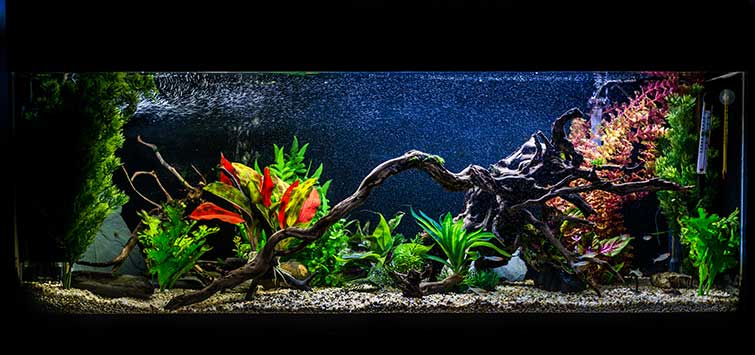Filtration
Filtration technologies use a variety of designs, many of which combine more than one type of filtration—mechanical, chemical, and biological. All require that the tank water be passed over or through one or more media types and returned to the tank. The water movement can be powered either by an airlift or by a water pump.
Mechanical Filtration
- Mechanical filtration traps suspended particulates. The water is clearer, but the wastes continue to add to the bioload of the aquarium until the medium is cleaned or replaced.
- Water polishing is accomplished by forcing the water under pressure through either diatomaceous earth or micron media. This removes the tiniest suspended matter—even microscopic organisms.
Chemical Filtration
- Chemical filtration media take up impurities from the water. Carbon’s effect is quite broad, adsorbing a wide variety of dissolved chemicals, while resins are usually very specific, targeted to remove a single impurity, like phosphate.
- These media remove the substances immediately from the water, but they are quickly saturated and must be replaced regularly. Long after they cease to adsorb, however, they often provide significant biofiltration by providing substrate for bacterial colonies.
Biological Filtration
- Bacteria are the most important part of an aquarium filtration system. Various species feed on ammonia, a highly toxic substance produced both by fish metabolism and by decomposition, which they convert to nitrite (still quite toxic). Then other bacteria feed on the nitrite, converting it to nitrate, which is relatively harmless at low concentrations.
- These bacteria need a well-oxygenated place to grow; they will colonize any suitable surface in the system. Biofilters are typically highly porous media through which water is pumped. Because air contains 20,000 times more oxygen than water, massive bacterial colonies can be maintained by wet-dry technology, in which water is sprayed or dribbled over a medium; since it is merely kept moist, the thin film of water is constantly bathed in oxygen-rich air.
Most filtration is artificial, and it partially makes up for the limitations of a closed system; in nature the buildup of waste products is typically prevented by volume dilution of wastes. In the aquarium, regular water changes help close the gap, but filtration is necessary unless there is a high-rate flow-through system, or unless complete daily water changes are performed. Under either of these regimens filtration is not necessary, but otherwise it is—except under conditions of extremely light stocking.
Types of Filters
Box Filters: These are plastic boxes fitted with a perforated lid and a lift tube. The lift tube connects to an air hose, and the bubbles rise up the tube from the bottom of the box. Filtration media are packed around the lift tube, filling the box. Water flows down through the media and up the tube, drawn by the rising stream of air bubbles.
Outside Filters: Most common today is the hang-on power filter. They use a pump to suck water up a supply tube from the aquarium. The water then flows through a series of compartments with various media and back into the tank via an overflow. These filters are available in a full range of sizes. A good rule of thumb is to select a filter with a flow rate at least six times the volume of the tank—so for a 30-gallon tank you want a flow rate of about 200 gph (gallons per hour).
Canister Filters: Canister filters also have an integral water pump. Their main appeal is that since this is a pressure system, all of the water is forced to flow through all of the media. They offer excellent filtration for large setups because of this, and they perform the job with a lower water flow.
Sponge Filters: A sponge filter is usually as simple as a sponge attached to a riser tube. Water is drawn through the sponge and out the other end of the tube, either by airlift or by powerhead. These filters are perfect for fry tanks, and they are easily cleaned by gently squeezing the sponge in a bucket of tank water. Sponge filters are extremely useful, but they aren’t decorative, so they are much more often used in breeding and rearing tanks rather than in display setups.
Sand Filters: Sand filters operate on the same principle as quicksand, as water from the tank is pumped upward through a sandbed, causing the sand particles to go into suspension. A prefilter is necessary to prevent debris from clogging the sandbed. The constant friction of the grains rubbing against each other prevents a buildup from forming, keeping the surface area free for new bacterial colonization.
Trickle Filters: Trickle or wet-dry filters drip or spray aquarium water over a medium. This maximizes oxygen saturation and provides excellent biofiltration. These units are extremely efficient at converting ammonia to nitrate. In fact, they are known as nitrate factories in the reef hobby, where avoiding nitrate buildup is extremely important.
Protein Skimmers
- Protein skimmers are used in marine setups to remove dissolved substances before they begin to break down. Some models stand alone (or hang on the tank) with their own water pumps, and others are designed to operate in a sump, utilizing the sump’s plumbing and pump.
- Water is pumped through a tall vertical column in which air bubbles are rising. The air can be supplied by an air pump or by a water pump with venturi, which is a valve that draws air into the water stream. The basic principle here is to get air bubbles into prolonged contact with the aquarium water. Polluting substances are attracted to the air-water interface of an air bubble. These concentrate in the bubble stream, rising with it and appearing at the top as foam. The foam continues to rise into a collection apparatus, while the water flows back into the tank.
Filter Media
- Most modern filters are modular, and you can vary the medium modules you use to fit your particular needs. Polyester padding and activated carbon are universally available, and common options include zeolite for ammonia removal, resins for phosphorous removal, ceramic for biofiltration surface area, and empty modules you can fill with whatever media you like. For example, people trying to breed certain rainforest species often use peat moss as a medium to soften and acidify the water. On the other hand, hobbyists trying to raise the hardness and pH of their water might use crushed coral as a medium.
- Many manufacturers offer modules in a gradation of weave or pore sizes so that you can stack them from large to small to trap increasingly finer particles. This also provides an efficient prefilter to prevent the pores of a biomedium from becoming plugged.
Chemical Reactors
- Chemical reactors are basically chambers in which aquarium water reacts with some medium to alter the aquarium water chemistry, either adding substances to the water or removing them. As long as it is a chemical reaction, and the medium is freely mixing with the water, the device is called a reactor. If, on the other hand, it is a physical reaction, or if the media is held in place and the water just flows through it, we normally call the device a filter, though the line can become fuzzy in some instances.
- Two common examples are calcium and phosphate reactors. In the first, a calcium carbonate medium and carbon dioxide gas are mixed. The water leaving the reactor is higher in calcium and alkalinity than the water flowing in. This maintains the high levels of calcium needed in tanks with growing corals and clams. Phosphate reactors circulate the tank water in a chamber with a phosphate-removing medium. Phosphate is constantly added to the aquarium in the foods given to the tank inhabitants. The use of a phosphate reactor can keep phosphate levels from rising.
UV Sterilizers
- Rather than removing or adding substances, an ultraviolet (UV) sterilizer kills living organisms. Tank water is circulated through a chamber exposed to UV radiation from a special bulb. The longer the water is in contact with the UV radiation, the better.
- UV sterilizers are indiscriminate—they kill all living organisms, from algae cells to pathogens. Thus, they are widely used to control disease. When properly matched to the aquarium size they can destroy any free-swimming pathogens or parasites. In pond setups they are often used to control greenwater algae blooms. In fishrooms with central filtration setups they are indispensable in preventing disease from spreading throughout the system.
How to Get Rid of Yellow Water
I have had my fish-only saltwater tank set up for two years, but recently the water has a yellow cast. What is causing that and how can I get rid of it? Lloyd Griffin (Loveland, Colorado)
The yellow water is caused by dissolved organic compounds. You can get rid of the yellowish cast by stepping up the frequency of your partial water changes and by filtering the water with activated carbon. If you want to prevent future buildups of yellow water, I would suggest getting a protein skimmer, or a better one if you already have one.
You could concentrate on having lots of activated carbon filtration. That can even be accomplished with inside air-driven box filters. The important thing is to change the carbon frequently and regularly. But since the carbon also becomes a biological filter, it is good practice to have at least two filters of activated carbon and only change one filter at a time.

.png?h=595&iar=0&w=2781&hash=5FD5E69473BCC22199FBFA2FB71B6033)



